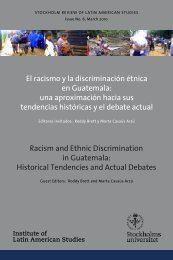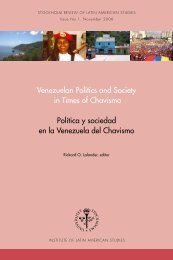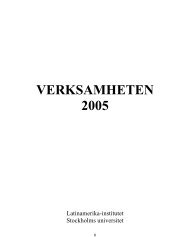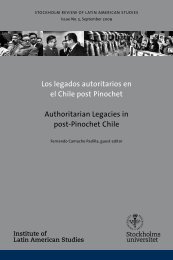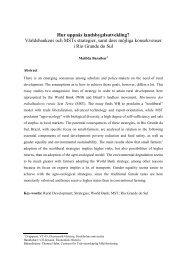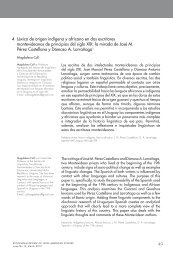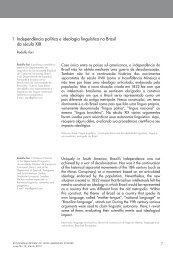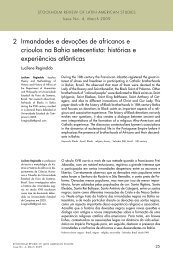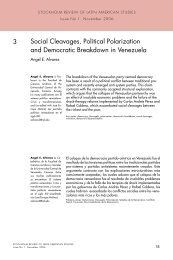„clubs‟- deliberately, intuitively or inherently- would make use <strong>of</strong> European and North <strong>American</strong>cultural production, values and life style as status enhancing tool, within class conflictingsocieties, in order to maintain, or obtain, a superior social rank at one‟s eyes.Secondly, we will discuss what the media role in this process is; how paid media connects thosewho can afford to the Western Society in a more direct way and keeps those who cannot pay forit in “the Third World”. For this task, as for the aforementioned one, theories would be appliedover Brazilian society – because <strong>of</strong> its postcolonial country characteristics, solid mediaproduction, among others. Moreover, we will discuss how a latecomer medium, Internet,somewhat can modify this scenario through the democratization <strong>of</strong> access to foreign signs.2. Brazilian Society - Today and YesterdayTo juxtapose Brazilian society and Globalization process is, firstly, necessary to understand howsome values inherent to the Brazilian culture were created. In this context, white, foreign,European or, simply, Western people (in the modern concept <strong>of</strong> word) always had a ratherprivileged position – in practical and/or subjective ways- in <strong>Latin</strong> <strong>American</strong> countries. It is rathersymbolical, if not prophetical, to remember that Europeans that first stepped over <strong>American</strong> soilwere considered by some local tribes as “Gods” (Bueno, 1998) that have brought from heavennew gadgets, values, believes and ways <strong>of</strong> life. Since that period, European supremacy haschanged its bearing and coverings but never left its preeminence. From farm lords during theslavery times, where to be European meant to be a free man, to the earlier European immigrantsthat introduced a new salaried class outside cities, Europe has a unique position within Brazilianpeople subconscious.One would argue that such scenario could not be different once Brazilian social values were builtup over European parameters and thus, even after its colonial period, Brazil still seeing in European example to be sought. Once more a plausible explanation for such picture lies upon thecountry history as a „colonized‟ nation as:“Imperialism did not maintain its rule merely through suppression, but through theexport and institutionalization <strong>of</strong> European ways <strong>of</strong> life, organizational structures, valuesand interpersonal relations, language and cultural products that <strong>of</strong>ten remained andcontinued to have impact even once the imperialists themselves had gone home”.(Sreberny-Mohammadi. 1997: 51).5
a. THE IMPORTANCE IN BEING PART OF THE ‘ELITE’There are several characteristics that make Brazil rather different than many <strong>of</strong> the countries overwhich the globalization process is mostly thought, but certainly none can match in importancethe economic gap between classes that comes about in the country. The Brazilian economicinequality is so determinant and well known that became one <strong>of</strong> the most significant traitspointed by sociologists and novel writers when trying to explain or portray Brazilian society.Brazilian almost folkloric class dissimilarity, embodied on local telenovelas (soap operas) and interms such “Belindia” -an expression coined during the 70‟s that describes Brazil as a fictionalcountry where a small wealthy part <strong>of</strong> the population live in wealth Belgium while the great masslive in poor India (Bacha, 1974) -, is also present in more scientific ways to determinate howbroad the gap is as the Gini Coefficient 2 . According to data from the 2004 United NationsHuman Development Report (HDR) Brazil has a coefficient Gini close to 0.6 - which places thecountry as the 8 th most uneven state on the world when comes to wealth distribution amongst127 nations that are in the report 3 .As being an inegualitarian society with its roots on a plantation model - which made use <strong>of</strong> bothslavery and peonage in different period <strong>of</strong> its history- Brazilian society has much <strong>of</strong> itsconceptions based on classism and social hierarchy (Freyre, 1933. DaMatta 1991. Almeida2007). The latter, somewhat based on the former, is a rather strong peculiarity in Portuguese<strong>American</strong> culture that surpasses the State figure and its assumptions that everybody is equalbefore the law. As a matter <strong>of</strong> fact, is believed that some Brazilians- in situations in which anequalitarian treatment becomes intolerable- do the question: “você sabe com quem está falando?"(Do you know who you are talking to?), an expression immortalized by the sociologist RobertoDaMatta (DaMatta, 1991) that exposes the hierarchic characteristic <strong>of</strong> Brazilian society.According to the sociologist, Alberto Almeida, that tried out DaMatta‟s conception on a survey2 Gini coefficient is a way to measure social inequality developed by Corrado Gini. It is commonly used to calculatethe inequality in distribution <strong>of</strong> wealth. It consists in a number between 0 and 1, where 0 means a completeequality in wealth share (where everybody has the same income) and 1 means totally inequality (where one has allthe income <strong>of</strong> a given group while all other don’t have anything).3 2004 UN Human Development Report. http://hdr.undp.org/en/. Accessed on May 25 th , 20086
- Page 2 and 3:
AbstractThis article explores some
- Page 4 and 5:
displaced people in relation to the
- Page 6:
Colombian case as a particular cond
- Page 9 and 10:
displacement instead of rejecting d
- Page 11 and 12:
5. Inter American Court contributio
- Page 13 and 14:
Moreover, the displaced are subject
- Page 15 and 16:
fabric on which lies the basis of t
- Page 17 and 18:
assistance; the right to exercise b
- Page 19 and 20:
ordinating and improving assistance
- Page 21 and 22:
and brutalisation of the armed conf
- Page 23 and 24:
subjects a free legal consultation
- Page 25 and 26:
8. Conclusions: how can the protect
- Page 27 and 28:
ReferencesACNUR, Balance de la pol
- Page 29 and 30:
FAMIG (Fundación de atención al m
- Page 31 and 32:
Una comunidad de Pazfrente al Estad
- Page 33 and 34:
salud y la educación. La pérdida
- Page 35 and 36:
gobierno es: “ser propositivo y d
- Page 37 and 38:
esidente y a los refugiados que van
- Page 39 and 40:
paramilitares, las comunidades camp
- Page 41 and 42:
asesinado. 28 Esta afirmación fue
- Page 43 and 44:
Los habitantes desplazados solicita
- Page 45 and 46:
La segunda detención de Elkin Dari
- Page 47 and 48: Comunidad decidió declarar en la C
- Page 49 and 50: Comunidad de San José de Apartadó
- Page 51 and 52: Brigada XVII del Ejército. 62 Al d
- Page 53 and 54: la impunidad en que se mantienen, y
- Page 55 and 56: como la mafia o el narcotráfico, s
- Page 57 and 58: Ratifican su existencia como una Co
- Page 59 and 60: La autonomía de las comunidades ch
- Page 61 and 62: A violência no romance O matador d
- Page 63 and 64: “The characters are emptied of co
- Page 65 and 66: pelos leitores, confrontando o leit
- Page 67 and 68: No caso da segunda vítima, o que p
- Page 69 and 70: meios para um tratamento odontológ
- Page 71 and 72: acompanhado seu trabalho” (Melo 1
- Page 73 and 74: LINS, Paulo (1997): Cidade de Deus:
- Page 75 and 76: transformação social. O Direito d
- Page 77 and 78: Constituição deveria ser a expres
- Page 79 and 80: O problema central desta discussão
- Page 81 and 82: Transitórias. A revisão é mais a
- Page 83 and 84: ultrapassada, que reduz o Direito
- Page 85 and 86: construção do discurso do estado
- Page 87 and 88: socialismo; o povo de El Salvador e
- Page 89 and 90: inquisição. Ser espanhol era ser
- Page 91 and 92: existência de um suposto “pacto
- Page 93 and 94: da família.Outro aspecto important
- Page 95 and 96: AbstractIn the past two decades, gl
- Page 97: 1. Introduction„Globalization Soc
- Page 101 and 102: 1990). However certain authors argu
- Page 103 and 104: author Jô Soares, that aims to upp
- Page 105 and 106: at home (…) and playing popular s
- Page 107 and 108: cannot afford, but is also a questi
- Page 109 and 110: Proportion of individuals that have
- Page 111 and 112: the distinction between the deterri
- Page 113 and 114: Routledge.Online References-2004 Un
- Page 115 and 116: IntroducciónEl presente trabajo se
- Page 117 and 118: datos históricos acerca del valor
- Page 119 and 120: producciones de La Gaceta, así com
- Page 121 and 122: En lo que refiere a los discursos p
- Page 123 and 124: marchar por algo, y si esta identid
- Page 125 and 126: de representaciones del pasado con
- Page 127 and 128: ApéndiceNota de La Gaceta, secció
- Page 129 and 130: Atte.-„Que se vayan los que no si
- Page 131 and 132: Ciudades blancas. Crónicas rojasLa
- Page 133 and 134: econocimiento de su condición de c
- Page 135 and 136: itmo de cumbia en esa zona que de l
- Page 137 and 138: Los pibes chorros todavía mantiene
- Page 139 and 140: El texto entra dentro de la línea
- Page 141 and 142: El 11 de febrero de 1999, Magdalena
- Page 143 and 144: Speranza, Graciela, “Cómo vivir
- Page 145 and 146: Sin la complejidad teórica de Ratz
- Page 147 and 148: pone el énfasis en la organizació
- Page 149 and 150:
el siglo XX, no logra conformar un
- Page 151 and 152:
primera) biografía sobre Raúl Pre
- Page 153 and 154:
Una rápida consulta a los periódi
- Page 155 and 156:
valiosos de la vida colectiva. Se t
- Page 157 and 158:
identificado como un caso de narrad
- Page 159 and 160:
La joven se refiere al arma que la
- Page 161 and 162:
Todas las veces en las que pudo mor
- Page 163 and 164:
atravesando una quinta a oscuras, c
- Page 165 and 166:
Notas:1 El proyecto consta de dos p
- Page 167 and 168:
Consumption society challenged: Bra
- Page 169 and 170:
due to unequal land distribution we
- Page 171 and 172:
Hence, the neo-liberal free trade a
- Page 173 and 174:
een to stand up to neo-liberalism a
- Page 175 and 176:
structural adjustment programs and
- Page 177 and 178:
a participant in the larger counter
- Page 179 and 180:
Löwy, Michael 2001. “The socio-r
- Page 181:
World Bank 2002. “What is empower



